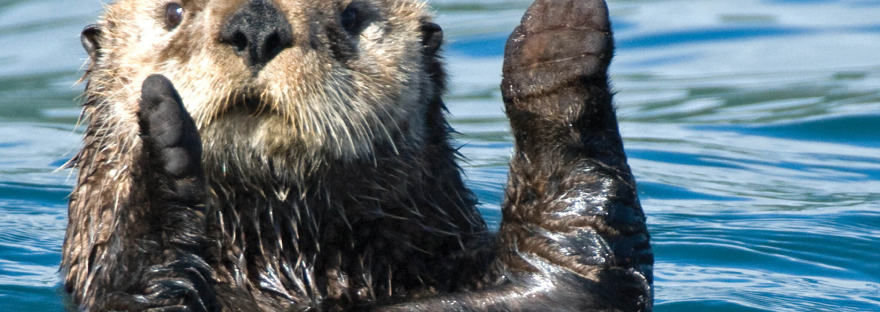Haida Gwaii, homeland of the Haida people, is a set of islands off British Columbia where the spirit bears (white black bears) can be seen. The Haida fought off logging interests and set up conservation areas. Now they are awaiting the return of sea otters with a mixture of hope and concern.

Sea otters voraciously eat shellfish, a significant source of food and money for the people there. But the booming shellfish business is a sign of an ecosystem out of whack. Sea otters love to eat sea urchins which can devastate beds of kelp, critical habitat and also a food source.
While a thriving shellfish population might be good for business, it also indicates an environment deeply out of whack. Because, though Ku/Kuu consume greedily, they repay with equal generosity. When an area of the ocean is devoid of sea otters, urchins can run amok. Where there should be waving fields of kelp, instead the ocean is nearly empty of greenery.
Everything depends on everything else.
Haida saying
Sea otters were extirpated, hunted to local extinction because of their dense pelts, by the Russians and later Europeans. It’s ironic that this returning population is in part due to the Cold War and nuclear testing, back in the 1960’s.
When Atomic Energy Commission staff discovered a population of cuddly sea otters at their next test site, they feared a public-relations disaster. To avoid an outcry, they captured and relocated hundreds of otters — airlifting them in aquarium-like tanks to sites in southeast Alaska, Oregon, Washington and the west coast of Vancouver Island. The 89 sea otters relocated to Vancouver Island were the first British Columbia had seen in 40 years.
The first sightings were treated like Big Foot. While ancient Haida totem poles and oral history showed them that sea otters had been part of their land, it was before living memory. But soon a mom and pups were found. So the Haida realized they needed to plan for their return, using both indigenous and western science.
The main lesson the Haida heard from other First Nations? To plan ahead and to draw from their traditional knowledge. “I think the most striking thing was that when sea otters were reintroduced [in the late 1960s and early 1970s], the Nations there weren’t involved in that conversation at all,” says Guujaaw. “They were all in a reactionary position, whereas I think we are better situated to be playing an active and leading role in the management.”
The middens and oral history have shown that the Haida had historically managed the otter populations through hunting.
The hunt wasn’t just open season though. Otter remains in middens show there was a fairly consistent harvest of the animals over time, suggesting their population was carefully maintained.
https://canadiangeographic.ca/articles/the-otter-the-urchin-and-the-haida/
They will be modeling the impact of non-lethal means of managing the population as well.


1 thought on “Haida people preparing for the return of sea otters”
Comments are closed.